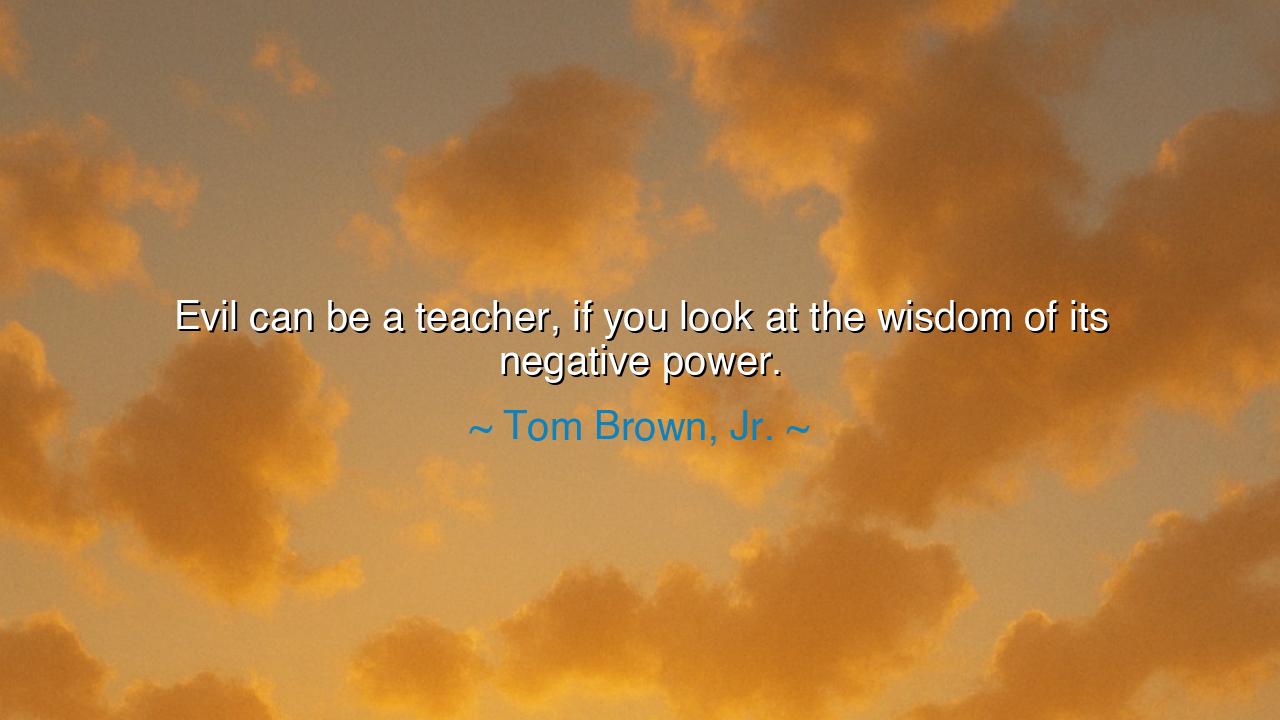
Evil can be a teacher, if you look at the wisdom of its negative






The words of Tom Brown, Jr.—“Evil can be a teacher, if you look at the wisdom of its negative power”—speak with the quiet authority of one who has observed the shadows of the human soul. Here, evil is not simply a force to be shunned, but a mirror, a teacher whose lessons are harsh yet profound. In its negative power lies the potential for insight: by witnessing cruelty, deceit, or malice, one can discern the boundaries of virtue, understand the fragility of trust, and cultivate the strength to resist corruption. Evil, in this sense, becomes a teacher, revealing truths that comfort and harmony often conceal.
The meaning of this reflection is that life’s adversities, dangers, and encounters with malevolence are not mere misfortunes—they are opportunities for learning. Just as fire forges steel, encounters with evil can temper the mind and spirit, if approached with awareness and reflection. To ignore or flee from evil may shield the body, but it leaves the soul untested and the understanding of human nature incomplete. Wisdom is often born in the crucible of challenge, in the confrontation with the darkness that lurks both in the world and within ourselves.
History offers abundant testimony to this principle. Consider the life of Nelson Mandela, imprisoned for decades under the tyranny of apartheid. Surrounded by injustice, cruelty, and oppression, he could have been consumed by bitterness and hatred. Yet he used the experience of systemic evil as a teacher, learning patience, strategic thinking, and the power of reconciliation. In time, he emerged not only as a liberator but as a figure of extraordinary wisdom, showing the world that the lessons of darkness, when heeded, can illuminate the path toward justice and compassion.
Even in literature, we see the truth of Brown’s observation. In Dante’s Divine Comedy, the Inferno presents the depths of human sin and corruption. Dante does not merely depict evil as punishment; he observes its nature, understanding the consequences and the structures that give rise to malevolence. By engaging with the negative power of sin, the poet gains insight into virtue, justice, and the moral architecture of the human world. Evil, in its starkness, becomes a teacher that reveals the contours of right living.
The lesson for us, O seekers, is that we need not court evil, but we must recognize its instructional potential. When confronted with malice, betrayal, or injustice, pause and observe: What does this reveal about human nature? What can it teach about resilience, morality, or the consequences of unchecked desire? The negative power of evil holds a mirror to our own choices and illuminates paths that avoid suffering and corruption.
Practically, this means cultivating vigilance and reflection. When harm arises, examine it without attachment, seeking the wisdom embedded in the challenge. Study history, human behavior, and personal experiences to discern patterns of evil, learning to anticipate and mitigate its effects. Use adversity as a teacher, allowing its harsh lessons to sharpen judgment, strengthen character, and deepen compassion. The goal is not to glorify darkness, but to extract insight from it, transforming potential destruction into guidance.
Thus let it be remembered: evil is both shadow and instructor. Its negative power need not destroy the spirit; it can illuminate the mind. Tom Brown, Jr. reminds us that wisdom is not found only in comfort, but in attentive observation of the forces that challenge, threaten, and test us. By heeding the lessons of adversity and malice, we strengthen our understanding of human nature, cultivate moral clarity, and learn to navigate the world with courage and discernment.






AAdministratorAdministrator
Welcome, honored guests. Please leave a comment, we will respond soon